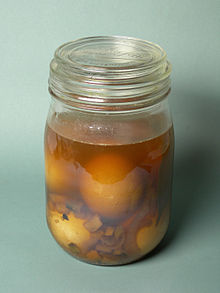Solei
Sole eggs are hard-boiled eggs pickled in a strong saline solution . The salt solution preserves the eggs and can be kept for some time without refrigeration. They are a traditional dish in large parts of Germany and were part of the standard menu from the “ Hunger Tower ” in numerous pubs .
Manufacturing
To prepare brine eggs, the hard-boiled eggs are first beaten all around so that their shell breaks without tearing open, and then placed in a large, sealable jar. Then a strong, boiled brew of water and salt, depending on the recipe also seasoned with z. B. Caraway seeds , peppercorns , allspice , juniper berries , bay leaves , cloves , onions and onion skins, pour hot over the eggs so that they are completely covered. The brew should contain enough salt for the eggs to float (approx. 60 g of salt in 1 liter of water). Sole eggs should be steeped for a day to a week before consumption. Due to the onion skins and other ingredients, a brownish pattern forms on the eggs along the break points of the eggshell.
Sole eggs are usually eaten as a snack between meals as follows: The egg is peeled and halved lengthways, the yolk is removed, a little oil , vinegar and pepper are placed in the cavity, half the yolk is put back on top, a little mustard is added and the half egg is taken with a bite consumed.
durability
There are different opinions about the shelf life of sole eggs. After about four weeks of storage in the brine, the egg yolk begins to turn green to bluish in color and a slightly sulphurous odor develops. In principle, sole eggs are still edible after a few months.
origin
There are several theories about the origin of sole eggs:
Durability in winter
As it is well known that chickens lay fewer eggs in winter, some of the eggs that were laid in spring, summer or autumn were soaked in brine so that they can be preserved and eaten until the winter months.
Connection with the practice of fasting
During the fast before Easter (when the chickens were laying well) eggs were abundant. They were saved and preserved in brine until they could be eaten at the end of Lent.
See also
Web links
Individual evidence
- ↑ Thomas Gandow: Where do the Easter customs come from. In: jesus.ch. June 24, 2010, accessed March 31, 2018 .

